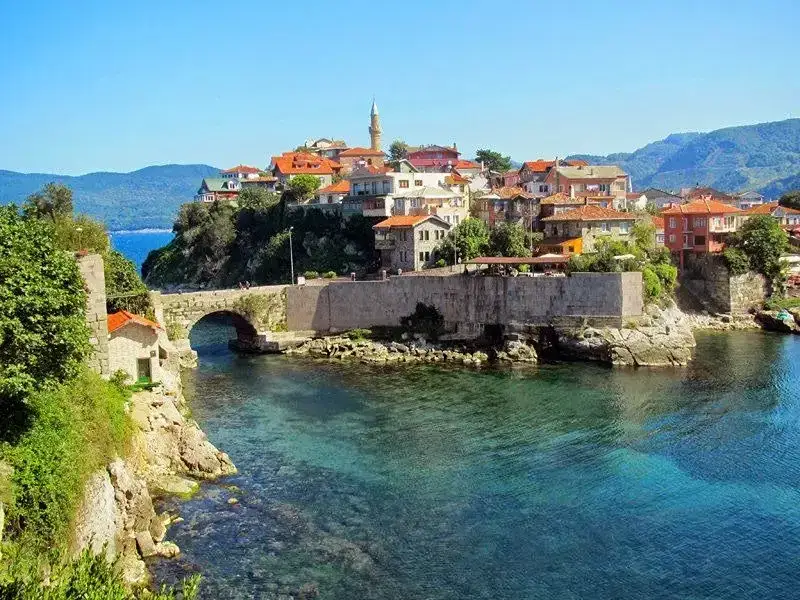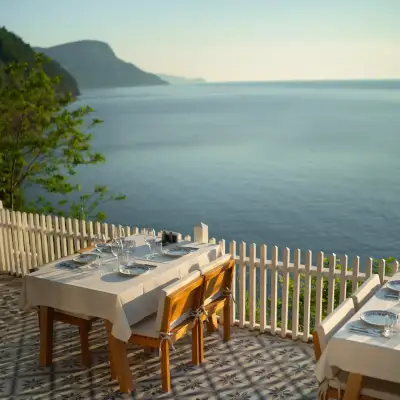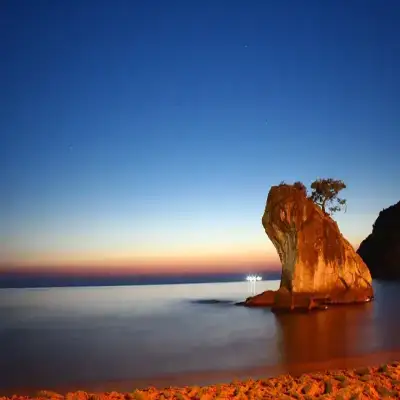
Amasra Guide
It was established on the charming hills embraced from three sides by Kocaçay and Kocanaz streams forming the Bartın river and 12 km. inland from the sea. Bartın is admired for its historical, cultural and folkloric values such as the 700 year old church building, 100-300 year old mosques, bridges, inns, baths, and wooden Bartın houses resembling a painting summarizing the recent history, traditional Garıla Bazaar and weddings, Telkırma manuscripts, one of the handicrafts reflecting the patterns of centuries with silver sparkling lights, distinguished local cuisine and strawberry festival, and interesting natural values that allow for sea, river, cave, plateau and hunting tourism. The mountains, although not high, are quite steep, steep and rocky towards the coast. The most important mountains are Aladağ, Kocadağ, Karadağ, Kayaardı, Karasu and Arıt Mountains. The city center is surrounded by Aladağ Mountains from the west, Karasu Mountains from the north and Arıt Mountains from the east. Halatçıyaması, Orduyeri, Kırtepe and Ömertepesi are four important hills on which the city was founded. The land, which is deeply dissected by the Bartın River and its tributaries, has a very rugged appearance. There are narrow and deep valleys in the areas where the river expands and between the very steep slopes of the mountains. Flat plains increase as you go down to the city centers. The most important plateaus of Bartın are Uluyayla, Ardıç, Gezen and Arıt plateaus. Arıt plateau is located within the Küre Mountains National Park.The most important river of Bartın is the Bartın River, which was called Parthenios in BC and gave its name to the city. The river, formed by Koca tea and Kocanaz tea, which merge at Gazhane Cape in the city center, flows 15 km. and reaches the Black Sea at the Bosphorus location. While Kocanaz Stream originates from the south and flows from Kozcağız to the north, Koca Stream consists of Göksu and Eldeş Streams (Ulus Stream) coming from Kastamonu and passing through Ulus and the streams joining them. Kışla Stream, Akpınar and Karaçay Streams, which merge with Kozlu Stream consisting of Arıt and Mevren Streams, are the streams that feed Kocaçay. Other important streams are Kapısuyu and Tekkeönü streams that originate in Kurucaşile and reach the Black Sea, and Ovaçayı and İnönü streams that irrigate Ulus-Uluyayla. Bartın River is the most regular river on which 500-ton ships can be transported from the Black Sea to the city. The flow rate is 720 meters per hour and 1.000.000.000 m3 of water flows into the sea every year. Of Bartın's 2143 km2 surface area, 46% is covered by forests, 35% by agricultural areas, 7% by meadows and pastures, and 12% by uncultivable areas and settlement centers. In the Black Sea region, which shows a very mixed situation in terms of plant geography; plant groups and species belonging to both Black Sea and Euro-Siberian plant geography can be seen. Forests, which occupy a large place in the vegetation of Bartın, are generally composed of spreading and coniferous trees. The characteristic trees of the area up to 600 m. along the coast are Oak, Beech and Hornbeam. Beech, Chestnut, Fir and Pine species are widespread inland from the coast and at elevations above 1500 m. Walnut, Chestnut and Hazelnut plantations are common along the coastline. Other tree and plant species; Cranberry, Medlar, Blackberry, Linden, Rosehip, Fig, Sage, Asparagus, Laurel, Ivy, Oleander, Rhododendron, Rhododendron, Clover, Clover, Clover, Comfrey, Jasmine, privet, Hawthorn, Bellflower, Chamomile, Hinduba, Euphorbia, Clover, Clover, Comfrey, The sub-flora of the region is composed of Sinirot, Primrose, Poplar, Menengiç, Sumac, Gum, Stickybush, Yavşan, Shepherd's Purse, Spruce, Cypress, Kocayemiş, Dönbaba, Heather, Abdestbozan, Katırtırnağı, Arapotu, Çirişotu, Thyme and hundreds of sub-flora.
Among the product pattern of the region whose soil character and climate are suitable for vineyard-garden agriculture; almost all of the field crops, vegetables and fruit species can be counted. In addition; Strawberry cultivation, for which a festival has been organized in recent years, attracts attention. There are no plant species protected under the Bern Convention in Bartın. Bartın's fauna consists of bivalves, reptiles, mammals and birds. Among the symbiotic species, we can count frog species and banded salamanders; among reptiles, we can count geckos, lizards, snakes and tortoises; among mammals, we can count wolves, jackals, weasels, badgers, foxes, tree martens, squirrels, hedgehogs, moles, moles, seven-tails, mice, brown bears, wild boars, hares, roe deer and bats. Bird species include storks, hawks, falcons, falcons, owls, hawks, jays, magpies, magpies, stepchicks, cuckoos, coots, coots, sparrows, pine titmice, woodpeckers, warblers, quail, partridges, pheasants, woodcock, black chickens and thrushes. Bartın has a temperate maritime climate (Black Sea Climate) with hot summers and cool winters. Its proximity to the sea and the fact that the mountain ranges, which are not very high, are parallel to the coast, generally cause the temperature differences on the coastline to decrease, the humidity to increase and to be under the influence of air masses coming from the Balkans.
For accommodation suggestions, you can check our Amasya Hotels page.



